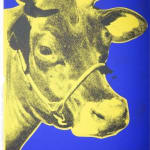

Andy Warhol
115.6 x 75.6 cm
Warhol’s Cow series marks a distinct departure from his typical subjects—celebrities, consumer goods, and other icons of mass culture. This surprising shift was inspired by Ivan Karp, a key figure in the 1960s New York art scene, who famously suggested to Warhol, “Why don’t you paint some cows? They’re so wonderfully pastoral and such a durable image in the history of the arts.” (POPism: The Warhol Sixties, 22). The result was a new chapter in Warhol’s exploration of imagery, where the familiar cow became the unlikely subject of Pop Art’s bold aesthetic.
Printed in 1971, Cow (FS.II 12) embodies this artistic pivot. Rather than focusing on the commercially saturated or sensational, Warhol chose an image with historical resonance—an animal rooted in agrarian tradition and art history. Yet, through Warhol’s lens, the pastoral becomes playful, electric, and irreverently modern. With a vibrant yellow cow set against a saturated blue background, Cow 12 transforms a humble image into a jarring visual experience, underscoring the power of Pop Art to reframe the ordinary.
While the cow may seem out of step with Warhol’s usual subjects, the series exemplifies his larger ambition: to question what art can be and what images are worthy of reproduction. By treating a centuries-old artistic motif with the same serial, silkscreen technique he applied to Marilyn Monroe or Campbell’s Soup, Warhol elevated the cow to cultural icon status. The juxtaposition of high-contrast colors imbues the subject with unexpected energy and wit—attributes often absent from traditional depictions of livestock.
The image used in the series was selected by Warhol’s longtime collaborator Gerard Malanga, after which Warhol executed the coloring—a testament to his factory-style method and collaborative ethos. Still, it is Warhol’s chromatic decisions that give the Cow prints their signature character. The bold palettes challenge viewers’ expectations, rendering the cow almost absurd in its stylization—comic, celebratory, and striking.
More than just a series of prints, the Cow works were also Warhol’s first experiment with wallpaper. Originally conceived for his 1966 exhibition at the Leo Castelli Gallery, the cow motif was printed in repeating patterns to cover gallery walls—a move that playfully blurred the line between fine art and interior design. Though Cow 12 came five years later, it continued this lineage, pushing the boundaries of how art could occupy space and engage its environment.
Positioned mid-way through the evolution of the Cow series, Cow 12 reflects Warhol’s continued interest in using radical color combinations—this time electric blue and canary yellow—to create visual impact. As the series progressed, Warhol experimented with different color pairings, but few are as vibrant and striking as Cow 12. The Revolver Gallery holds multiple variations from this body of work, including Cow 12A, a rare version of Cow 11A, and a signed Cow 11A, underscoring the lasting appeal and variety within the series.
Ultimately, Cow (FS.II 12) serves as proof of Warhol’s ability to transcend time-bound cultural commentary. While his celebrity portraits anchor him to a specific era, works like the Cow series demonstrate a broader artistic ambition—to reimagine enduring symbols through the lens of Pop. In doing so, Warhol asserts that even the most traditional subject can be revitalized, democratized, and made newly iconic.
For more information on Andy Warhol’s Cow (FS.II 12) or to buy Cow (FS.II 12), contact our galleries using the form below.
Join our mailing list
* denotes required fields
We will process the personal data you have supplied in accordance with our privacy policy (available on request). You can unsubscribe or change your preferences at any time by clicking the link in our emails.
This website uses cookies
This site uses cookies to help make it more useful to you. Find out more about cookies.





